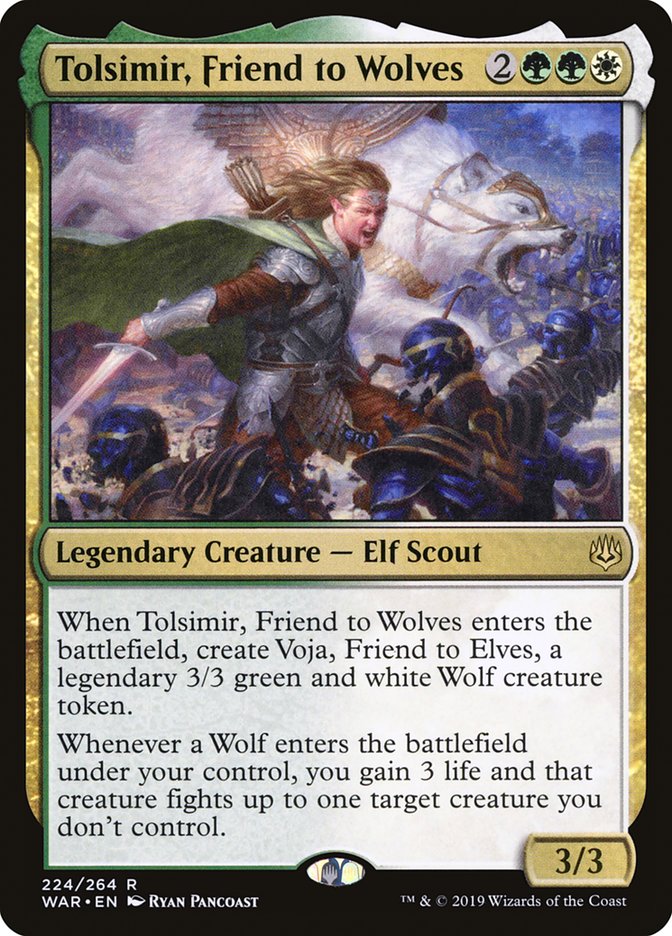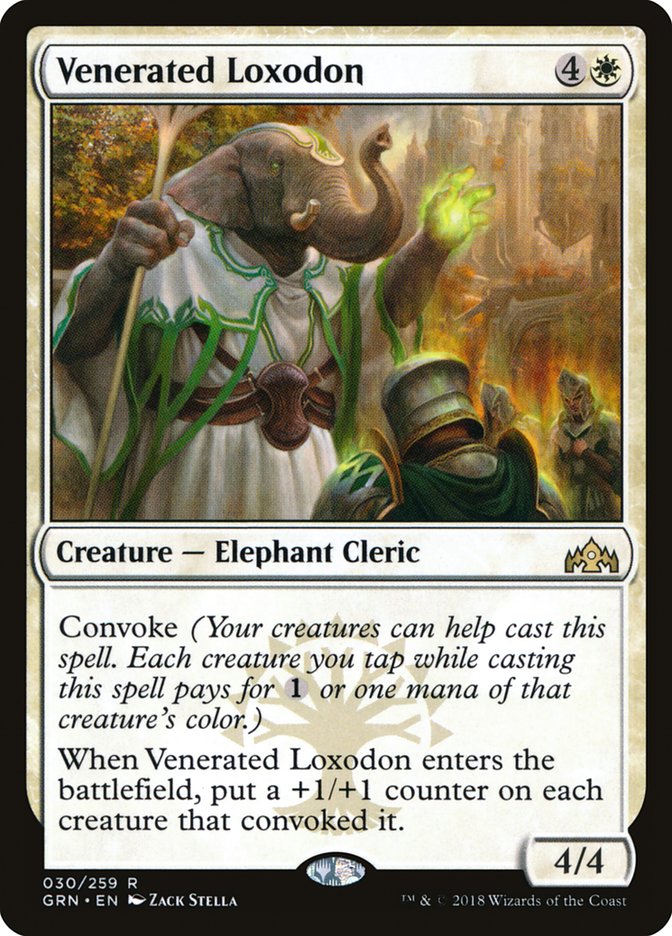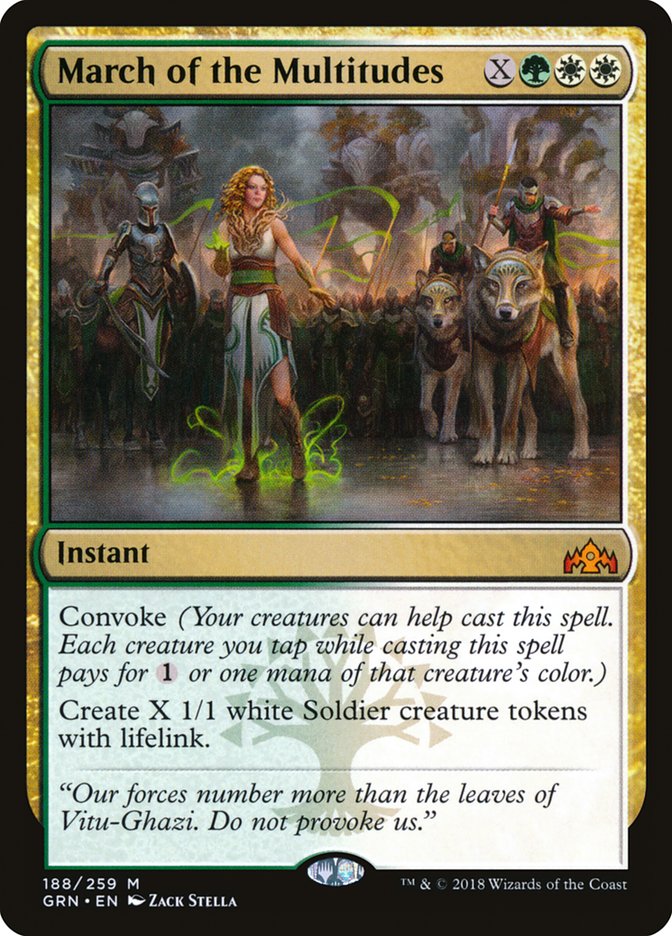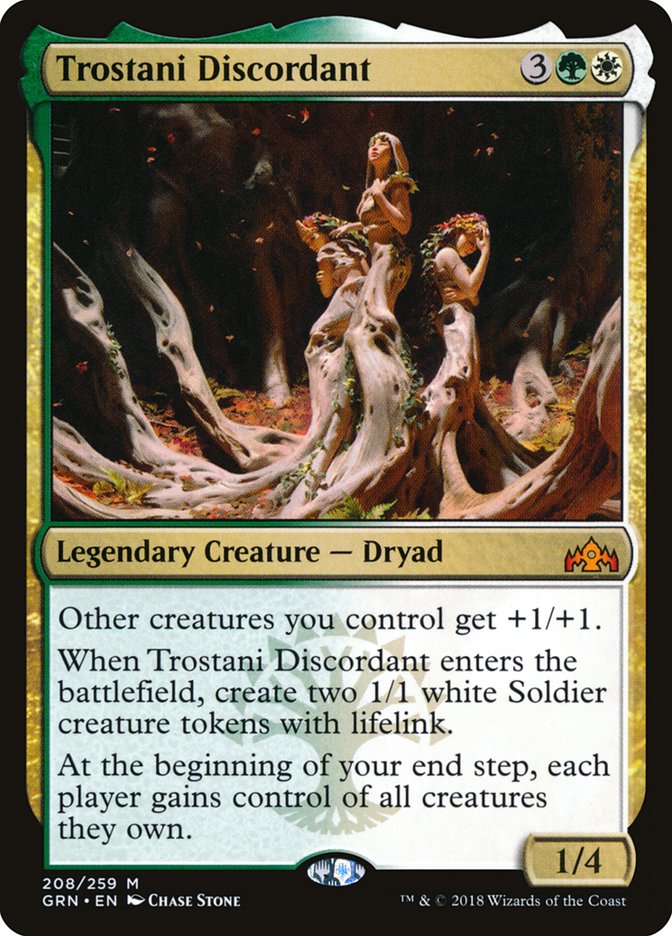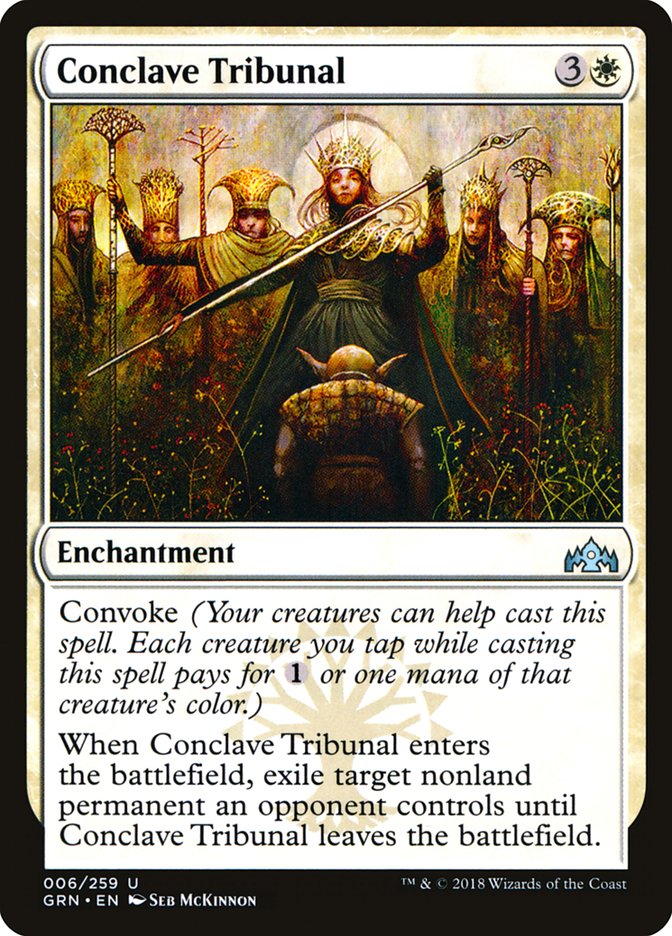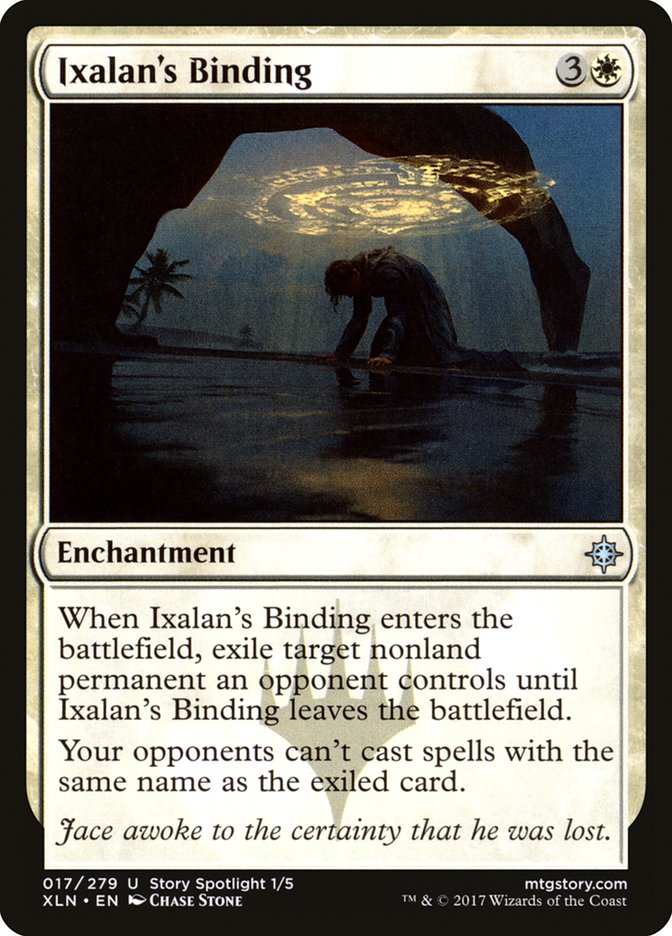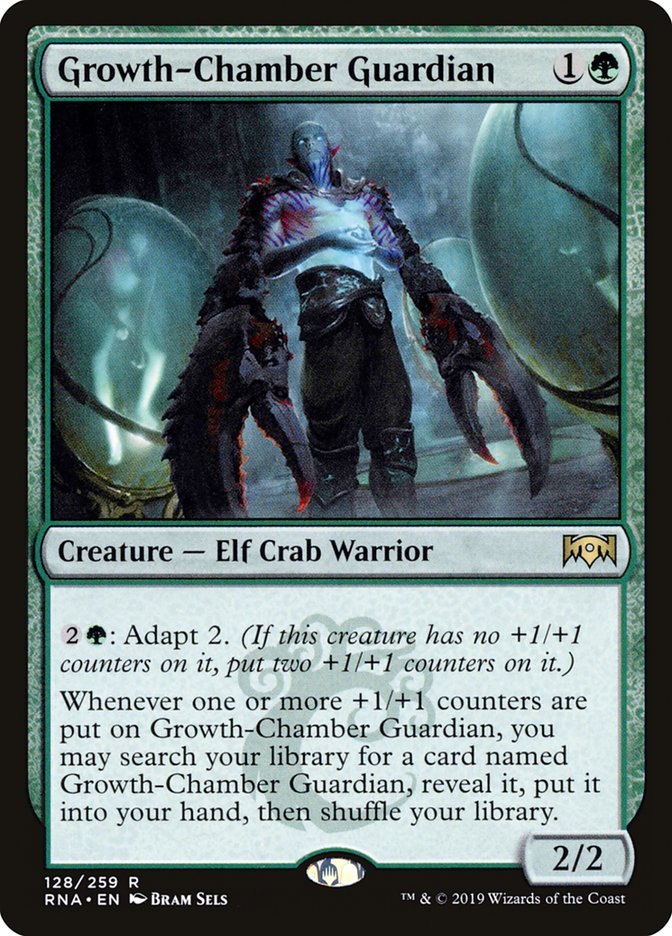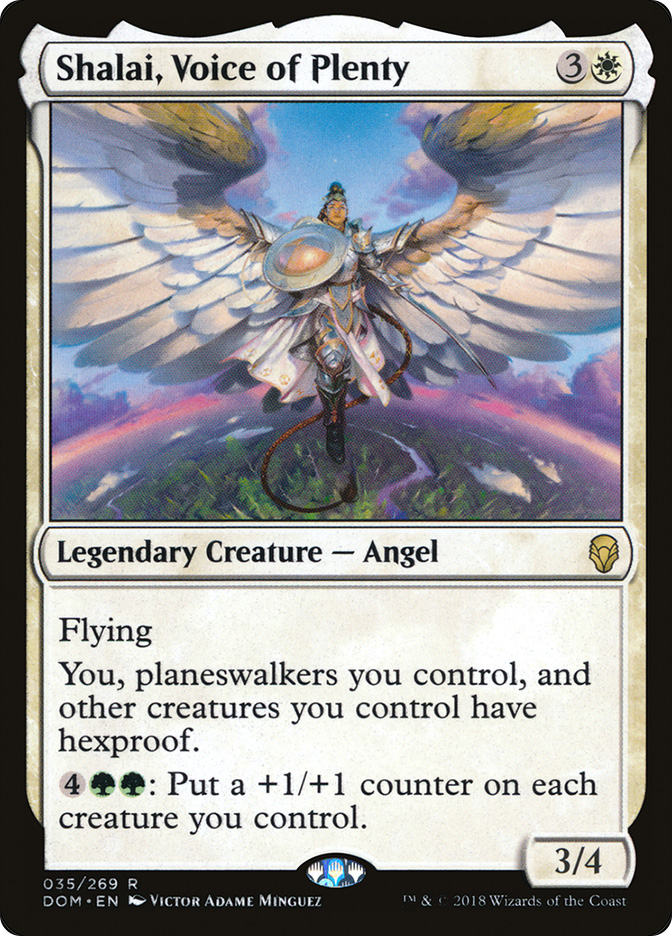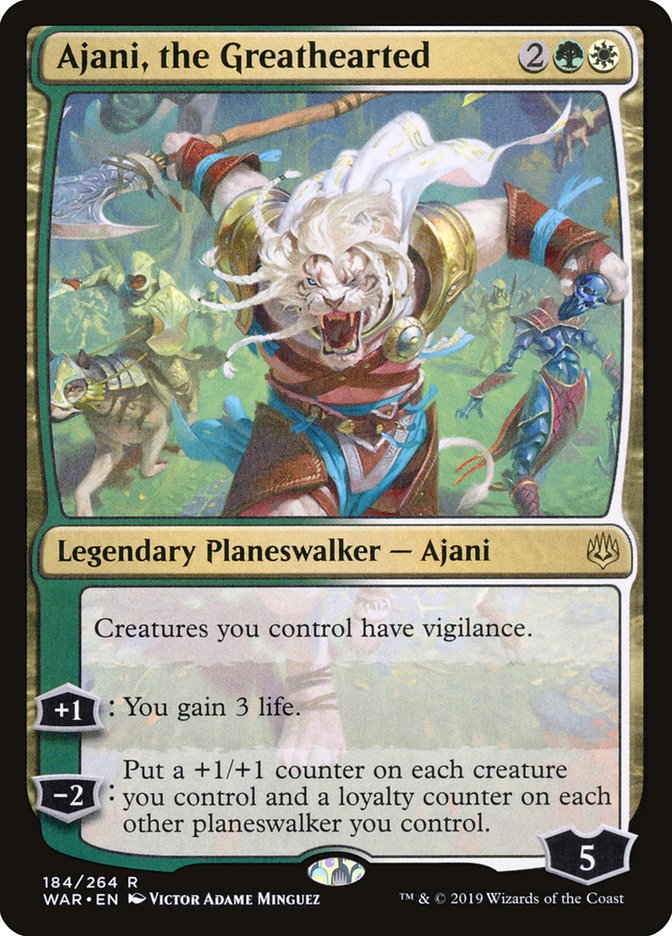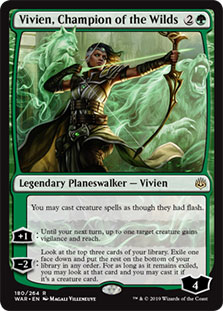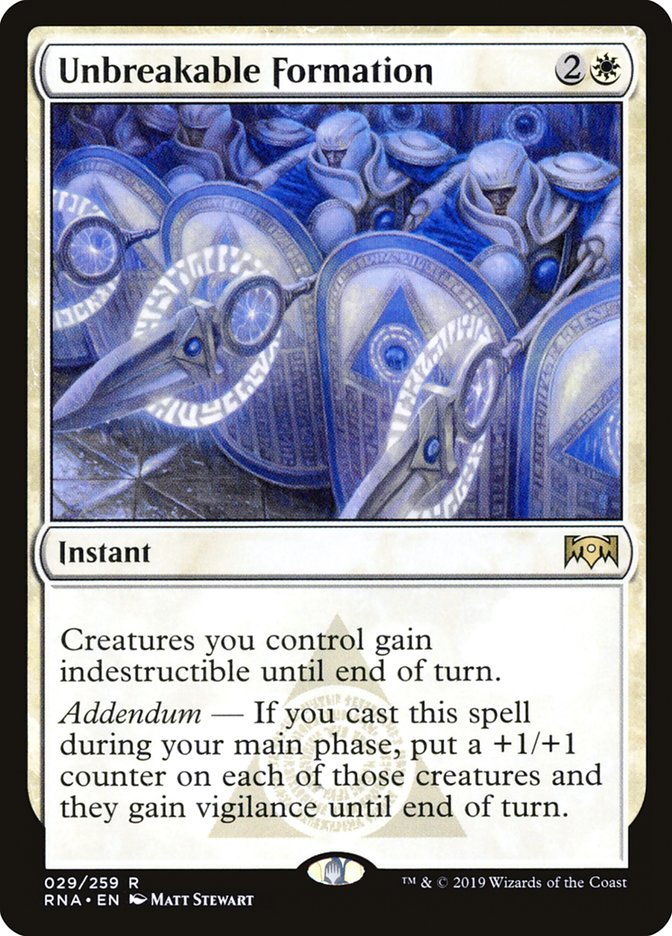Since the release of Guilds of Ravnica, Selesnya has had a clear identity: tokens. With several efficient token generators at the early point of the curve and a pile of great convoke cards to power out with those tokens, the deck took shape very early, becoming one of the best-performing decks in the early days of the season before falling behind Golgari (now Sultai) Midrange and some of the other top decks in the format.
But with every new set comes the capacity for change, and there’s a very powerful card in War of the Spark that pushes Selesnya in a different direction:
There’s a lot of text on the card, which is generally a good sign, but also means there’s a lot to think about before we go about putting it into a deck. First, let’s look at the raw stats.
- Five mana
- Six power
- Two bodies
That’s solid, but we’re going to need more than a Crested Herdcaller to break into Constructed. Gaining three life and the ability to fight a creature with the token is quite a bit more. That’s going to stabilize most battlefields against an aggressive deck, if not put you solidly ahead. Against midrange decks, you can take out a mana creature to stymie their curve or even a Hostage Taker to undo the big swing. And against control, the fight trigger gives you a built-in answer to Thief of Sanity, which won’t come up often but will be game-winning when it does.
When the life is less relevant, the fact that Tolsimir’s power is split among two bodies will matter, so the card is well-rounded, making it perfect for a midrange strategy. For my money, the card reads favorably compared to other five-mana creatures in Standard like Trostani Discordant and Biogenic Ooze. It certainly has more immediate impact than those two, which is very important for cards that fall high on the curve.
However, despite being a card that literally makes a creature token, I don’t see Tolsimir slotting into Selesnya Tokens. That’s very much a synergy-driven deck where the expensive cards are specifically designed to play off the early token generators. Venerated Loxodon, March of the Multitudes, and Trostani Discordant all need a wide battlefield of creatures to be effective, and when you have that battlefield, they are among the most powerful effects in Standard for the cost. Tolsimir doesn’t have the scalability, but it’s a significantly better standalone card, so decks with it need to be built with that in mind.
What are the benefits to building around Tolsimir rather than the well-established token theme? First, you gain more flexibility in deckbuilding and sideboarding. In order for the token synergies to play out, you need to have a certain number of enablers. That limits your ability to add other powerful cards as the metagame shifts and makes it difficult to react to cards that naturally line up well against tokens, like Goblin Chainwhirler or Massacre Girl. Versatility is becoming more and more important in Magic these days, and I see Tolsimir as powerful enough to stand next to what the Tokens decks do without being forced to flesh out those synergies with most of your list.
Second, the primary weakness of Selesnya is its paucity of removal. Conclave Tribunal and Ixalan’s Binding can answer anything, but they don’t play well in large numbers, since they are rather expensive, and the cheap removal in white, mostly Baffling End, isn’t on par with Cast Down and Lava Coil. Tolsimir lets you bake some extra removal into the deck for free, especially against aggressive decks. There’s a lot to like here, and I’m ready to see what else Selesnya can do.
So let’s start from the ground up. The first thing to notice is that Tolsimir plays very well with mana creatures. Later in the game there’s more of a chance that the 3/3s are outclassed by larger creatures, which also means the value of any creature you can fight is lower. This is especially true when fighting mana creatures. If you’re able to accelerate into Tolsimir, Friend to Wolves and answer an opposing Llanowar Elves or Incubation Druid, you deny your opponent a lot of tempo, whereas answering it on Turn 5, while still good, will not have the same effect.
Of course, adding mana creatures to a midrange deck is a dangerous possibility, because you need enough lands to consistently make land drops and actually accelerate rather than use the mana creatures to keep up, which makes the deck very heavy on mana sources and thus prone to flooding. Selesnya Tokens has four copies of March of the Multitudes, but we must look elsewhere.
Lastly, Tolsimir is excellent at defending planeswalkers. The 3/3s can team up to take down a larger attacker and the fight ability combined with two blockers can handle opponents who try to go wide. So I want to use planeswalkers as the primary source of card advantage, which fortunately is easy to do when we’re getting 37 new planeswalkers in one set.
Keeping these principles in mind, I built the following list:
Creatures (26)
- 4 Llanowar Elves
- 3 Jadelight Ranger
- 3 Shalai, Voice of Plenty
- 2 Knight of Autumn
- 2 Tithe Taker
- 4 Growth-Chamber Guardian
- 4 Incubation Druid
- 4 Tolsimir, Friend to Wolves
Planeswalkers (7)
Lands (8)
Spells (19)
- 10 Forest
- 6 Plains
- 3 Ixalan's Binding

With the increased presence of mana creatures, I decided to eschew the explore package that’s so common in green midrange decks and instead am playing Growth-Chamber Guardian, a card that has failed to live up to its preview season hype but is still quite powerful and serves as one of the deck’s mana sinks. Jadelight Ranger remains here since it’s simply the best three-drop available, at least along with Knight of Autumn.
The second mana sink is Shalai, Voice of Plenty, which lets your battlefield of 3/3s, 4/4s and mana creatures go over the top of larger creatures, an important avenue of attack for longer games, especially against other midrange decks. I also like the hexproof aspect of the card, because Tolsimir needs to survive in order for Voja, Friend to Elves to enter the battlefield and fight. Shalai either eats a removal spell immediately, thus tying up the opponent’s mana, or grants Tolsimir hexproof to make sure its friend gets permission to come out and play.
The natural curve of “Shalai, Tolsimir, activate Shalai” can turn the corner against aggressive decks as well as end games quickly against control and Wilderness Reclamation decks, and it’s self-contained in two cards that are difficult to answer profitably and have significant immediate impact.
As for the planeswalkers, Vivien Reid is the obvious one, a proven Standard all-star that provides an incredibly source of card advantage and necessary interaction against a wide array of permanents. Vivien Reid is joined by two newcomers that, while lower on the curve, look quite powerful.
Ajani, the Greathearted provides another Anthem effect – one that synergizes nicely with Growth-Chamber Guardian, but also vigilance, which is super-valuable in such a combat-oriented deck. For a deck like Selesnya Tokens, vigilance on a pile of 1/1s and 2/2s won’t move the needle by much because you’re often throwing away tokens to attack anyway, but with slightly larger creatures, the value of vigilance is super-high, letting you turn the corner against aggressive decks and dominate combat in midrange mirrors. Vigilance also makes it much easier to defend your planeswalkers, ensuring that your advantage engines keep chugging until you’ve buried your opponent.
And Ajani isn’t even the most important new planeswalker for the deck, a title which belongs once again to Vivien, this time in the slightly smaller form of Vivien, Champion of the Wilds. It’s another source of card advantage and the +1 ability functions like Ajani, the Greathearted on a smaller scale to help you in combat, this time also containing fliers, but the real star here is granting all your creatures flash.
With Tolsimir, flash allows you to time the card so that it’s not vulnerable to removal, but also to let the fight trigger act as a combat trick, blowing out double blocks or making it nigh-impossible for your opponent to figure out how to attack. Knight of Autumn at instant speed is excellent against Wilderness Reclamation, and with Growth-Chamber Guardian, you have a mana sink on the battlefield that disguises your hand and gives you something else to do with your mana should you not have a good creature to deploy.
But the creature that benefits most from gaining flash is Shalai, Voice of Plenty, which becomes a Plaxmanta after a big bowl of Wheaties. Vivien, Champion of the Wilds’s static ability gives this deck a level of trickiness that is unheard of from Selesnya decks, making all your opponent’s decisions harder while also providing some insulation against sweepers, since you can rebuild your battlefield starting on the opponent’s end step.
The power of Vivien also motivated the inclusion of Tithe Taker, since the tax on spells cast on your turn incentivizes your opponent to play at sorcery speed, thus letting you react appropriately. When they only have four mana, that Vraska’s Contempt could be cast into a potential Shalai, or it could not be cast at all during that turn cycle, and that’s yet another tough decision to make for your opponents.
The sideboard is mostly typical for Selesnya colors, but I want to try out Single Combat and Unbreakable Formation. The former is excellent against go-wide strategies like Azorius Aggro and Selesnya Tokens, since neither is likely to have a single threat that can dominate the battlefield, and the fact that you get to keep your best thing makes it better than a straight Wrath of God in most cases.
Unbreakable Formation completes the flash gameplan against control decks. With Viven, Champion of the Wilds or Growth-Chamber Guardian, you can easily hold up the three mana for it and advance your position should a Kaya’s Wrath not show up. That sweeper is the scariest card you can see, so finding a way to blunt its effectiveness is huge for the control matchups.
I like everything that’s going on with this list, but I still worry about the low density of removal. Cards like Hostage Taker can be problematic, especially when backed by Vivien Reid to blow up Ixalan’s Binding. Don’t even get me started on the potential of getting your Knight of Autumn taken hostage, only to blow up an Ixalan’s Binding on another creature.
Tolsimir’s mana cost isn’t prohibitive enough to preclude a third color, but I prefer to look at a deck in a purer form before adapting it to problematic cards in the metagame. Selesnya Tokens has more restrictive mana costs and still manages to sometimes splash blue for some counterspells in the sideboard. I could see dipping into black for Cast Down or red for Lava Coil in order to give the deck a touch more removal, and maybe upgrade the lonely Jadelight Ranger with a more powerful standalone creature.
I’ve been big on Selesnya since the preview season for Guilds of Ravnica, ultimately calling it as the best guild in the set. Golgari seems to have spoiled my prognostication, but the best revenge would be for Selesnya to overtake Golgari by copying its mold with a well-tuned pile of good creatures, removal, and planeswalkers. Tolsimir, Friend to Wolves is the first step in that direction.
Am I happy to move away from a cool synergy deck to bland midrange that essentially equates to playing glorified Booster Draft? Not exactly, but as long as it plays Llanowar Elves, I’ll be okay.


